Rob Hadgraft's Blog, page 2
December 15, 2016
'King of the Milers' does the double for garden party guests!
MY year-long trek in the footsteps of forgotten British sporting hero Sydney Wooderson is nearly at an end. Fifty-nine of 60 of his racing venues are now ticked off the list.
The journey - not a continuous one you understand, but done in bits and pieces over the past 12 months - has served its purpose as a research tool for my forthcoming book. For those to whom his name means nothing, Sydney was 'King of the Milers' long before Joe Public had even heard of Roger Bannister. But just when Sydney was poised to achieve the first four-minute mile and Olympic glory, war was declared in 1939 and things got rather complicated. But that's a story I'll save for the book!
In the mean time I'm tracking down the scenes of his triumphs and this update covers my journey, mostly on foot, around the streets of SE London.
 *The former Private Banks sportsground, Catford Bridge.
*The former Private Banks sportsground, Catford Bridge.
My research told me Sydney raced at least a dozen times on the Private Banks Sportsground at Catford Bridge, a place that housed the 'home' track of his club Blackheath Harriers for many years. Athletics history was often written here. In fact, the very first Blackheath fixture here (in 1883) saw the charismatic Walter Goodall George run a mile in 4:24.5, which many regarded as the fastest mile in history to that point. It was no flash in the pan, for George later brought the record down to a sensational 4:12.75, a clocking that would keep his name near the top of the world rankings for more than half a century. George's remarkable life story is told in my 2006 book 'Beer and Brine', which can still be obtained via Amazon as an e-book (link: http://amzn.to/2h5DSla )
Sydney's appearances near the rail tracks at Catford Bridge were mostly 'domestic' club races of little national consequence. All these years later the ground remains a multi-use sports arena, but is nowadays owned by the independent St.Dunstan's College.
Within a short distance from here I found three more tracks trod by Sydney that have yet to disappear under new buildings, and two of them are still staging sporting events nearly 90 years later.
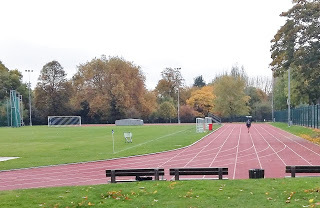
Ladywells Park/Arena (above) has been the home of Kent Athletic Club for well over 100 years. This is the club serving the Lewisham area, which only retains its rather misleading name for reasons of consistency and nostalgia, I was told. The running track here was first created in 1936, the same summer that saw Sydney smash the British mile record (4:10.8) with old Walter George turning up with his walking stick to see his long-standing mark finally beaten! Sydney ran here at Ladywells in May 1947, winning a two-mile race comfortably, helping Blackheath beat Cambridge Harriers in the process.
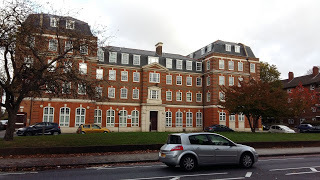
The smart, imposing building that still graces the north side of Eltham Road today (above) was created in 1912 as the Ravensbourne Club. It was a residential clubhouse and sports centre for the many employees of Cook, Son and Co.(St.Pauls) Ltd., a huge wholesale clothing company. This handsome four-storey block was refurbished in 2007 and retains its U-shape around a quadrangle at the rear, where there used to a be a swimming pool and running track.
Athletics historian Kevin Kelly has furnished me with images from the offical programme of the Annual Sports and Garden Party at Ravensbourne in summer 1937. Sydney did the 'double' that day, winning the mile handicap race easily and then helping Blackheath win the Kent mile relay championship.

Just down the road in the Grove Park area was the track (above) where Sydney pulled in big crowds to see him win two wartime half-mile races. Brian Boulton, himself a former Kent mile champion and President of Kent AAA, used to live and run in this district and he told me:
"Much of this City of London School sportsground is now owned by Eltham College. From 1950 till 1971 I lived nearby with my parents in a house backing on to the CLS grounds. For many years I used to train off-track by exiting our back gate to gain access to the College playing fields. I was athetics captain at the College in the late 1950s and later trained there with Glynis Goodburn, whom I coached before she married fellow long-distance star Keith Penny. The track I recall was not a standard shape, but pear-shaped."
* My biography of forgotten hero Sydney Wooderson will be published soon - the sixth in my series of books on running legends of the past.
Click for info: http://amzn.to/2hAQyBN
The journey - not a continuous one you understand, but done in bits and pieces over the past 12 months - has served its purpose as a research tool for my forthcoming book. For those to whom his name means nothing, Sydney was 'King of the Milers' long before Joe Public had even heard of Roger Bannister. But just when Sydney was poised to achieve the first four-minute mile and Olympic glory, war was declared in 1939 and things got rather complicated. But that's a story I'll save for the book!
In the mean time I'm tracking down the scenes of his triumphs and this update covers my journey, mostly on foot, around the streets of SE London.
 *The former Private Banks sportsground, Catford Bridge.
*The former Private Banks sportsground, Catford Bridge.My research told me Sydney raced at least a dozen times on the Private Banks Sportsground at Catford Bridge, a place that housed the 'home' track of his club Blackheath Harriers for many years. Athletics history was often written here. In fact, the very first Blackheath fixture here (in 1883) saw the charismatic Walter Goodall George run a mile in 4:24.5, which many regarded as the fastest mile in history to that point. It was no flash in the pan, for George later brought the record down to a sensational 4:12.75, a clocking that would keep his name near the top of the world rankings for more than half a century. George's remarkable life story is told in my 2006 book 'Beer and Brine', which can still be obtained via Amazon as an e-book (link: http://amzn.to/2h5DSla )
Sydney's appearances near the rail tracks at Catford Bridge were mostly 'domestic' club races of little national consequence. All these years later the ground remains a multi-use sports arena, but is nowadays owned by the independent St.Dunstan's College.
Within a short distance from here I found three more tracks trod by Sydney that have yet to disappear under new buildings, and two of them are still staging sporting events nearly 90 years later.

Ladywells Park/Arena (above) has been the home of Kent Athletic Club for well over 100 years. This is the club serving the Lewisham area, which only retains its rather misleading name for reasons of consistency and nostalgia, I was told. The running track here was first created in 1936, the same summer that saw Sydney smash the British mile record (4:10.8) with old Walter George turning up with his walking stick to see his long-standing mark finally beaten! Sydney ran here at Ladywells in May 1947, winning a two-mile race comfortably, helping Blackheath beat Cambridge Harriers in the process.

The smart, imposing building that still graces the north side of Eltham Road today (above) was created in 1912 as the Ravensbourne Club. It was a residential clubhouse and sports centre for the many employees of Cook, Son and Co.(St.Pauls) Ltd., a huge wholesale clothing company. This handsome four-storey block was refurbished in 2007 and retains its U-shape around a quadrangle at the rear, where there used to a be a swimming pool and running track.
Athletics historian Kevin Kelly has furnished me with images from the offical programme of the Annual Sports and Garden Party at Ravensbourne in summer 1937. Sydney did the 'double' that day, winning the mile handicap race easily and then helping Blackheath win the Kent mile relay championship.

Just down the road in the Grove Park area was the track (above) where Sydney pulled in big crowds to see him win two wartime half-mile races. Brian Boulton, himself a former Kent mile champion and President of Kent AAA, used to live and run in this district and he told me:
"Much of this City of London School sportsground is now owned by Eltham College. From 1950 till 1971 I lived nearby with my parents in a house backing on to the CLS grounds. For many years I used to train off-track by exiting our back gate to gain access to the College playing fields. I was athetics captain at the College in the late 1950s and later trained there with Glynis Goodburn, whom I coached before she married fellow long-distance star Keith Penny. The track I recall was not a standard shape, but pear-shaped."
* My biography of forgotten hero Sydney Wooderson will be published soon - the sixth in my series of books on running legends of the past.
Click for info: http://amzn.to/2hAQyBN
Published on December 15, 2016 07:47
November 30, 2016
Running wild on the Common: Black-clad Heathens from Hayes!
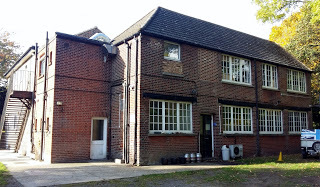
MY 2016 book-related quest to visit and run at 60 race venues graced by forgotten hero Sydney Wooderson was close to completion when I hit the Hayes area of SE London – the home patch of Sydney’s club Blackheath Harriers.
Locating places where Sydney’s track races were staged has been relatively simple, but finding his cross-country venues has proved a far more tricky business.
His club staged ‘home’ events from a number of different spots in the Hayes area, just south of Bromley. So who better to consult than a couple of the club’s past Presidents – two very helpful gents by the names of Mike Martineau and Chris Haines.
They told me about several different routes for Blackheath fixtures back in Sydney’s golden days of the 1930s and 1940s. These tended to be on or close to Hayes Common – a place that lends itself very nicely to cross-country races or a training spin. The Common is a vast oak woodland with small patches of lowland dry heath, dry acid grassland, lichen heath, scrub and ponds. These days there’s even an SSSI (site of special scientific interest) thrown in for good measure.
Sydney and his cronies would often gather less than half-a-mile from their Bourne Way clubhouse (pictured above), at a point halfway along Prestons Road in Hayes (pictured below). From a clearing here, a footpath heads south through the trees and is where virtually all club races used to start up until the late 1960s. From here runners would head down the main path, eventually finishing adjacent to a premises known to all as ‘The Café’.
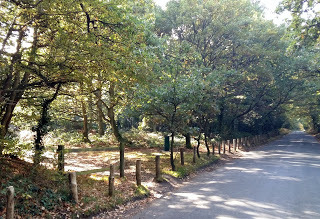 This post-race oasis was positioned at the busy Croydon Road end of Hartfield Crescent. These days it’s no longer a café, but the home of the ranger who looks after the Common. I know this because he was standing right there and politely enquired whether I was lost!
This post-race oasis was positioned at the busy Croydon Road end of Hartfield Crescent. These days it’s no longer a café, but the home of the ranger who looks after the Common. I know this because he was standing right there and politely enquired whether I was lost!There were a couple of exceptions in Sydney’s day to the Prestons Road-to-Cafe route. Blackheath’s five-mile handicap race would always start near the Bourne Way HQ, make its way up unmade Hillside Lane to finish, inevitably, at the ever-popular café.
And what became known as the ‘Schools Race’ (Blackheath regularly raced pupils from Sydney’s alma mater Sutton Valence) was held on farmland a mile or so from the club HQ, based at Wickham Court Farm just off Layhams Road, which is in West Wickham.
 Sydney hung up his spikes and racing flats for good in 1951, but for years afterwards would come along and help the club with timekeeping and other duties on these local courses. As ever, he was happy to support a club that he’d first joined in 1931.
Sydney hung up his spikes and racing flats for good in 1951, but for years afterwards would come along and help the club with timekeeping and other duties on these local courses. As ever, he was happy to support a club that he’d first joined in 1931. This club loyalty was a feature of his entire career in fact. Even when he was Britain’s most famous runner either side of the 1939-45 war, his main aim in cross-country races was to help the team effort and not necessarily chase personal glory.
Sydney was always ‘old school’ and liked nothing better than to score points and help clubmates from the outfit known nationwide as ‘The Heathens’. In 1969 he accepted the honour of serving them as President for their centenary year.
The club still occupies the same Bourne Way building it purchased for £850 in 1926, but nowadays call themselves Blackheath and Bromley Harriers AC, following a merger with Bromley AC in 2003.
Much has changed since Sydney’s day, of course, but the club still recognises him as the greatest Heathen of them all.
* My biography of forgotten hero Sydney Wooderson will be published in the not-too-distant future - the sixth in my series of books on running legends of the past. Click for info: http://amzn.to/1C2BjUK
Published on November 30, 2016 08:57
November 4, 2016
The slopes of Shotover and the cinders of Iffley Road
 * Sydney Wooderson imagined on the slopes of Shotover Hill!
* Sydney Wooderson imagined on the slopes of Shotover Hill!THREE times during his celebrated running career Sydney Wooderson tested himself on Oxford’s fearsome cross-country course at Shotover Hill.
The first was as a raw 20-year-old track specialist, who was only there to help his club out. The second visit – more than 12 years later - was a very different scenario. He was by then at the height of his powers as a cross-country man and just a few weeks away from becoming English champion. Sydney’s third and final Shotover run came at the tail end of his career, by which time his sole intention was again to merely grab a few scoring points for Blackheath, with no serious expectation of personal glory.
My year-long ‘challenge’ to visit and run at 60 of Sydney’s racing venues - in advance of publishing a book about him - took me up Shotover Hill on a grey and rainy day, armed as usual with running shoes, notebook and camera.
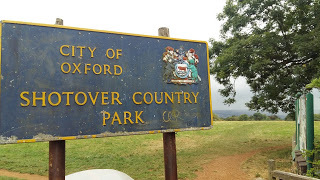 Apart from Sydney and other top runners, the place has seen plenty of excitement over the years. Shotover was once part of a Royal Forest providing a hunting ground for noblemen, fuel and grazing for local people and timber for Oxford’s historic buildings. After it became open farmland the main road to London passed across Shotover Plain and here travellers often fell victim to highwaymen.
Apart from Sydney and other top runners, the place has seen plenty of excitement over the years. Shotover was once part of a Royal Forest providing a hunting ground for noblemen, fuel and grazing for local people and timber for Oxford’s historic buildings. After it became open farmland the main road to London passed across Shotover Plain and here travellers often fell victim to highwaymen. Around the time Sydney ran here for the first time, the City Council began managing Shotover as a public park. During the war Slade Camp was set up to provide a temporary home for soldiers who took part in the D-Day landings and on the slopes of Shotover Hill military training took place and tanks were tested.
Runners of various sorts still frequent the area in 2016 in high numbers, slogging up the tricky slopes in kit rather more brightly coloured than when Sydney and cronies ran the Blackheath versus Oxford University ‘mob matches’ of yesteryear.
The weather was miserable for the duration of my visit - but I was assured the place is normally a riot of nature’s finest colours and aromas. At the foot of the hill are springs which feed marshes and pools fringed with aromatic water mint and further up delicate white flowers of heath bedstraw mingle with the red of sheep’s sorrel. The grasslands are popular with green woodpeckers looking for ant nests, while the bracken is full of foxes, muntjac and roe deer.
 *Sydney, imagined at RAF Halton . . . Earlier, before hitting Oxford, I called in at RAF Halton in Wendover, scene of a wartime match between airmen and guest runners who formed ‘The Combined Clubs’ team. With most young athletes occupied in one or other of the services, most sporting events of the era involved cobbling together teams in this way, but the watching public had no complaints and were glad of such entertainment on a summer’s afternoon.
*Sydney, imagined at RAF Halton . . . Earlier, before hitting Oxford, I called in at RAF Halton in Wendover, scene of a wartime match between airmen and guest runners who formed ‘The Combined Clubs’ team. With most young athletes occupied in one or other of the services, most sporting events of the era involved cobbling together teams in this way, but the watching public had no complaints and were glad of such entertainment on a summer’s afternoon. Sydney Wooderson, still world mile record holder, was of course the big attraction here at the airbase on Saturday 13 June 1942. The little man didn’t let his fans down and sped to an impressive victory in the mile race in 4:24.2. He was never really pressed, with teammate R.Hughes trailing in second ahead of the RAF’s Moore.
It would prove Sydney’s very last mile race as world record holder. Just 18 days later in Gothenburg, the mighty Swede Gunder Haegg grabbed the record for himself with a run of 4:06.2.
Sydney’s reaction to losing a record he’d held for five years no doubt included a rueful smile - for the likes of Haegg, living in neutral Sweden, had been able to escape the privations of war and was operating under a far more favourable dietary and training regime than British soldiers like Sydney.
 * . . . . and on the historic Iffley Road track!No visit to Oxford would be complete without a look at the legendary Iffley Road track, where Bannister broke the four-minute mile barrier. Sydney raced here in May 1943, part of a strong AAA team who took on an illness-depleted University outfit. Sydney moved away from the pack on the second lap of the 880 yards (half-mile) race, winning easily by 35 yards or so in 1:57.4. It was a race that gained a couple of column inches in the wartime papers, but nothing like the fuss this track would generate 11 years later when Bannister and his pals came to town!
* . . . . and on the historic Iffley Road track!No visit to Oxford would be complete without a look at the legendary Iffley Road track, where Bannister broke the four-minute mile barrier. Sydney raced here in May 1943, part of a strong AAA team who took on an illness-depleted University outfit. Sydney moved away from the pack on the second lap of the 880 yards (half-mile) race, winning easily by 35 yards or so in 1:57.4. It was a race that gained a couple of column inches in the wartime papers, but nothing like the fuss this track would generate 11 years later when Bannister and his pals came to town!
Published on November 04, 2016 10:05
October 28, 2016
Cross-country at school - not always a miserable memory!
ALTHOUGH he made his name circling cinder tracks at high speed, Sydney Wooderson always harboured a deep love of traversing open countryside – either by way of long Sunday walks, or by entering cross-country races.
This love seems to have stemmed from his days attending Sutton Valence School in the inter-war years. The Kent school placed a strong emphasis on sport and regularly sent its boys into the fresh air for cross-country jaunts across the nearby beauty spots of the Weald of Kent.
 * Weald of Kent, viewed from Boughton Monchelsea churchyard.A lifetime list of Sydney’s races shows that of his first 30 fixtures, all run as a teenager, at least half were cross-country races in this area. My year-long ‘challenge’ to visit and run at 60 of Sydney’s racing venues - in advance of publishing a book about him - took me out here, armed as usual with running shoes, notebook and camera.
* Weald of Kent, viewed from Boughton Monchelsea churchyard.A lifetime list of Sydney’s races shows that of his first 30 fixtures, all run as a teenager, at least half were cross-country races in this area. My year-long ‘challenge’ to visit and run at 60 of Sydney’s racing venues - in advance of publishing a book about him - took me out here, armed as usual with running shoes, notebook and camera. The record shows that Sydney’s first four races were all in the colours of Sutton Valence with many of his opponents older than him. All four were won by his elder brother Alfred, the school’s star athlete. Sydney would eventually emerge from Alfred’s shadow in the spring of 1931, aged 16, when he narrowly won a steeplechase of five-and-a-half miles in a time of 32.29.
The biggest conurbation by far in this area is Maidstone, but it would be fully ten years later before Sydney competed in this county town of Kent. It would ultimately amount to five races here, three cross-country battles and two track contests.
Crossing a down-at-heel housing estate, neglected footpaths and barbed wire, I was eventually able to locate the place where he made his Maidstone debut in wartime 1941 – the grass track used by the county’s Police HQ. Representing a combined Army/RAF team, Sydney anchored a medley relay against a Police & Medical Services team. He looked in good shape following recent injury troubles as he set off first over 880 yards, handing the baton to teammate Harold Wickerson and leaving his team well placed. They ultimately won by 20 yards and and the overall event by a big points margin.
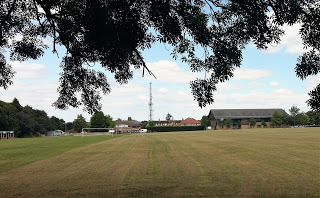 * The site of the former track at the Maidstone police HQ grounds.Sydney's first return to this track came five years later, at the Kent county champs of June 1946. No longer specialising at half-mile and mile, Sydney tested himself in the three miles event and became county top dog by clocking 14:59.2. It was the first county champs since war began nearly seven years earlier, but for Sydney it was more significant as an indicator of good things to come at longer distances.
* The site of the former track at the Maidstone police HQ grounds.Sydney's first return to this track came five years later, at the Kent county champs of June 1946. No longer specialising at half-mile and mile, Sydney tested himself in the three miles event and became county top dog by clocking 14:59.2. It was the first county champs since war began nearly seven years earlier, but for Sydney it was more significant as an indicator of good things to come at longer distances.Next for me was to locate the scene of Sydney’s various heroics in the Gillingham and Chatham area. Back in 1937 he’d made his bow at Gillingham’s United Services Sports ground, successfully defending his county mile title in hot sunshine and on a badly disintegrating cinder track. A relatively modest time of 4:30.8 was all it took to lift the crown, and his well-known electric burst of speed was only required for a brief surge in the second lap in order to establish a good position.
Just a week earlier he’d thrilled a big crowd at the White City, winning the Kinnaird Trophy mile in 4:17.1, but on that occasion conditions were better and the opposition stronger. Despite this, in some quarters of the press disappointment was expressed that Sydney had “only” managed 4.30 at Gillingham. If he was miffed by such criticism, he characteristically didn’t display it publicly, and it was left to the editor of his club’s newsletter to castigate the moaners.
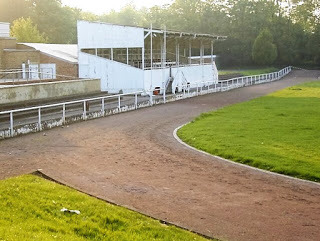 * The old United Services Sports ground at Gillingham.If any spectators at Gillingham were disappointed by his low-key cruise to victory they only had to wait another year, for the 1938 Southern championships were held at the same ground, and Sydney powered to a brilliant victory in the half-mile (1.56.4) beating title-holder Arthur Collyer into second place.
* The old United Services Sports ground at Gillingham.If any spectators at Gillingham were disappointed by his low-key cruise to victory they only had to wait another year, for the 1938 Southern championships were held at the same ground, and Sydney powered to a brilliant victory in the half-mile (1.56.4) beating title-holder Arthur Collyer into second place. Overcoming a gusty wind and poor track conditions, Sydney brushed off an episode of jostling to grab the lead less than 200 yards from home. Checking the progress of the chasing Collyer all the while, he nevertheless flew across the line some eight yards clear as the crowd roared its approval. It was a sensational demonstration of his superiority.
* Sydney Wooderson book on the way; My other biographies on Jim Peters, Arthur Newton, Alf Shrubb, Walter George, 'Deerfoot' and more, all available via Amazon. Click this link: http://amzn.to/1C2BjUK
Published on October 28, 2016 08:01
October 21, 2016
The Brighton adventures of Walter and Sydney
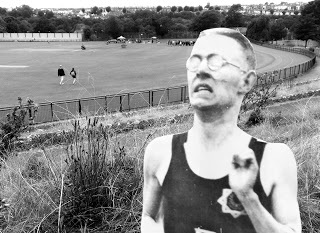
AND so to Preston Park, a substantial 63-acre chunk of recreational space on the edge of trendy Brighton. It’s a place that nowadays hosts the hugely popular Brighton Marathon, but in past decades witnessed the exploits of the most famous track runners and cyclists in the land.
A cinder running track was first laid here more than 100 years ago, sitting rather uncomfortably inside the banked velodrome track which is still there today. British mile legend Sydney Wooderson raced here just once – in the summer of 1937 aged 22 - and put on a memorable and powerful display that belied his tender years and lightweight frame.
My year-long ‘challenge’ to visit and run at 60 of Sydney’s racing venues - in advance of publishing a book about him - took me to Brighton via various places he also passed through late in his running career during annual London-Brighton Relays. Handcross, Hickstead (pic below), Hassocks and Patcham all witnessed his pattering feet on separate occasions as he dutifully swept through these places ‘transporting the baton’ for Blackheath Harriers.
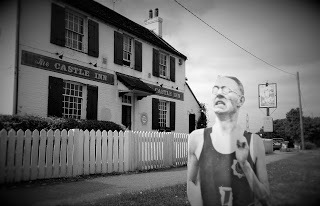
His selfless efforts on behalf of his beloved black-clad London club were admirable, but never was his talent more evident than when he regally cruised around the Preston Park track on Saturday 26 June 1937. On that day he won the Southern AAA championship mile ‘as he pleased’, to coin a phrase of the day.
Clocking laps of 64.5, 64.5 and 65 seconds, he looked in great shape tucked in behind the labouring leaders. Then, 350 yards from the end he suddenly produced that famous 'kick' and surged clear apparently effortlessly, putting in a final lap of 60.6 to win by 10-yards in 4:14.6. It was the best mile by a Brit since his own native record at Chelmsford a year earlier (4:10.8).
The experts reckoned it was only a matter of time before Sydney would set a world mile record – something no British-born runner had done since Walter George 50 years earlier, back when Victoria was on the throne.
W.G.George, a lively character who confessed to liking “a cigar, a drink and a spree” between training runs, had strong links with Brighton himself, having run here and worked as a junior dispensing chemist in the town.
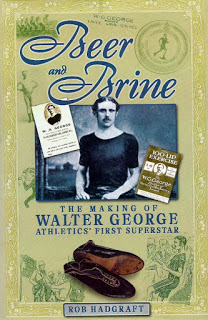
Walter and Sydney were both great milers, but it was there the similarity ended. While Sydney was small, bespectacled, introverted and a diligent city office worker, Walter was a tall, handsome fellow who loved his celebrity status and occasionally strayed into the type of trouble that didn’t befit an athlete of international status. By way of example, here’s just one of many tales about Walter I included in my biography of him, published several years ago:
“One typical episode involved a drunken midnight foot-race along Regent Street in Central London with some pals. Ignoring a bobby’s advice to go home to bed, Walter then trekked through the night to meet a lady-friend in another part of London. This was followed by a hectic morning’s shopping and a lavish lunch in the West End before our hero then bowled merrily into the Lillie Bridge stadium to casually smash a world record!”
I think it’s fair to say Sydney’s build-up to big races tended to be a little more circumspect than Walter’s . . . .
* BEER and BRINE – The Making of Walter George, Athletics’ First Superstar (Author: Rob Hadgraft, Publisher: Desert Island Books; Illustrated 256-page hardback, or as e-book). Available via Amazon - http://amzn.to/2dqqOZQ - or direct from the author).
Published on October 21, 2016 03:01
October 6, 2016
Mob matches on the Common - very democratic affairs!
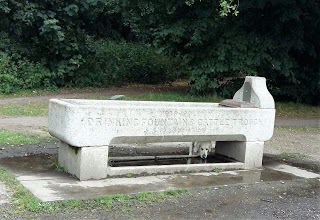 * Runners and dogs get thirsty on Wimbledon Common . . .FOUR Sydney Wooderson race venues ticked off in one hit. And the territory in between covered on foot too. That’s more like it!
* Runners and dogs get thirsty on Wimbledon Common . . .FOUR Sydney Wooderson race venues ticked off in one hit. And the territory in between covered on foot too. That’s more like it! One of the aims of my 60th birthday challenge was to knock off some extra training miles, so it was good to be able to park the car for several hours and tread in Sydney’s footsteps through park, heath and woods at Petersham, Wimbledon Common, Roehampton and Putney – all in one long sun-drenched slog on foot.
My research for the book tells me Sydney competed a total of seven times at these four places – club-level events with no particular historical significance. Most interesting of the bunch was a South of Thames cross-country championship that was fixed up during wartime on Wimbledon Common.
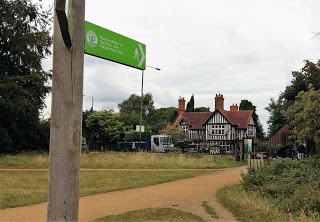 * The Dysart Arms opposite Richmond Park - a runners' landmark.
* The Dysart Arms opposite Richmond Park - a runners' landmark.
 * Into the trees off Putney Heath - an unhappy hunting ground for Sydney.
* Into the trees off Putney Heath - an unhappy hunting ground for Sydney.
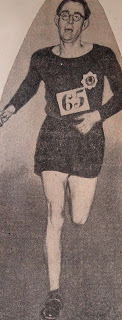 * Sydney pictured at Petersham in Jan 1940.The race took place on Saturday 10 February 1940, with Northern Europe in the grip of intensely cold weather. It was five months into the war and people were going about their lives as best they could in the trying circumstances. Hostilities didn’t prevent plenty of sport that weekend, The Times covering football between teams representing The Army and The Empire, a number of rugby fixtures, boxing, rowing, and greyhound racing. And over in SW London, Sydney Wooderson and 98 other runners toed the start-line on Wimbledon Common for the South of the Thames contest.
* Sydney pictured at Petersham in Jan 1940.The race took place on Saturday 10 February 1940, with Northern Europe in the grip of intensely cold weather. It was five months into the war and people were going about their lives as best they could in the trying circumstances. Hostilities didn’t prevent plenty of sport that weekend, The Times covering football between teams representing The Army and The Empire, a number of rugby fixtures, boxing, rowing, and greyhound racing. And over in SW London, Sydney Wooderson and 98 other runners toed the start-line on Wimbledon Common for the South of the Thames contest. It was a demanding five-mile route from Belgrave Harriers HQ and 13 men never made it to the finish. Frank Close of Surrey AC took the title, cruising home comfortably after pulling away from Sydney and the others in the first mile. Sydney was not at his fittest and happy to just enjoy the trip, coming in 16th, some 90 seconds behind the winner.
A year later Sydney would return to the same venue and place fifth in another five-miler, this time a contest between his club Blackheath and hosts Belgrave. Once again he was 90 seconds down on the victor, Tom Carter of Belgrave, who looked in a class of his own.
Towards the end of the war in January 1944 a short distance away on the common, close to Roehampton, Blackheath took on the runners of the London Fire Force, Thames Valley and host club Tyrian AC in a 4.5-mile cross-country contest. Sydney, by now in better racing shape, won this ‘mob match’ by a clear 17 seconds.
He’d sampled ‘mob match’ action earlier in the war, running from the popular Dysart Arms, home of Ranelagh Harriers, a spot beautifully positioned near the Thames in Petersham, on the western fringes of Richmond Park. Ranelagh, Orion and South London combined to form a team to take on Blackheath, but Sydney won this 1940 contest handsomely, prompting chatter in the sporting press over whether he might soon forsake track racing altogether and concentrate on becoming a success at cross-country.
Once the war was over Sydney did indeed quit serious track action (after one fabulous ‘farewell’ year) and turned his attentions to cross-country running. In Christmas week of 1946 he returned to the Dysart to help Blackheath to a comfortable victory over Ranelagh on a course of approaching 8 miles. John Poole of the host club won by a good distance, but the rest of the first ten home were all ‘Heathens’ – including a tie for second place between Sydney and teammates Choat, Reynolds and Keepex, who deliberately finished together.
Elsewhere in this fine sector of London, I discovered that Sydney’s only two races in the Putney area came very early in his career and were not happy experiences. As a 17-year-old competing for Sutton Valence in the Ranelagh Public Schools Cup in March 1932, he engineered himself a good position near the front of the pack, but lost all realistic chances of victory when falling and cutting his foot quite badly, continuing on but having to settle for sixth place. Then, in diabolical weather in December 1934 he wore the Blackheath colours in the annual Pelling Ratcliff Cup contest from Putney Heath. He could only manage 37th place on a day when conditions were so bad that the linen numbers on the runners’ vests curled up and became obscured thanks to “all the glutinous substances” that were flying around!
Those Putney races were enough to put a small chap wearing glasses off cross-country for life you’d think - but our Sydney was made of sterner stuff!
* PROJECT SYDNEY is more than just my forthcoming book about the forgotten British champion Sydney Wooderson. It also incorporates my 60th birthday ‘challenge’ – which was to visit and run at 60 of the places where Sydney raced during his remarkable career - all to be done while I am 60! This blog records the progress of that challenge, which, conveniently should also help keep me fit and assist with research!
* * NOTE: What is a MOB MATCH? Well, it’s a very ‘democratic’ running event between clubs, the method of scoring meaning virtually every runner – regardless of ability – has the chance to score points. You start by counting the number of runners on each side then take three off the smaller number. For example, if Blackheath had a turnout of 44 runners and Ranelagh 50, then the first 41 home from each club would score. The team with the lower score was the winner (first place counts 1 point, 2nd is 2 etc). So the result is not normally known until the last few tail-enders finish. It’s been going for more than 100 years and still happens here in the 21st century – the idea being invented by Ranelagh and Blackheath for their 1907 annual contest. This became established as the standard scoring method for all mob matches worldwide.
Published on October 06, 2016 06:52
September 23, 2016
When brothers finish together . . . not just a Brownlee thing!
 * The sports fields at Charterhouse.
* The sports fields at Charterhouse.THE crowded roads of the Surrey commuter belt can be unforgiving when you possess scant knowledge of local shortcuts or traffic hot-spots. Locating race venues around here that were once graced by athletics’ forgotten hero Sydney Wooderson proved a tall order.
However, I managed to find five of them in one trip, an exhausting rigmarole which keeps me ticking along nicely towards the 60 I pledged to visit in 2016. It’s all in the name of research, you see, and also part of my 60th birthday challenge!*
Of course, the original idea was to don running shoes and have a training run at all these venues, take a few photos and collect material for my next book. But, for logistical reasons, I confess the running part has recently been a little curtailed. As my ‘Old Grey Training Log’ will testify, those runs have lately been measured in metres rather than miles.
But the overall challenge remains alive and well, and here in the affluent Surrey/ Hampshire/ Berkshire triangle I was able to put a tick against venues numbering 29 to 33 on the list of 60.
Exiting Guildford Cricket Club (see previous blog), I dashed down to the Godalming district to call at famous independent school Charterhouse. The alma mater of my former Sports Editor, this seat of learning was founded in 1611 on the site of a monastery - and the bucolic surroundings still radiate a sense of calm and contemplation even today!
Sydney raced here three times in his career, all cross-country challenge races involving his club Blackheath Harriers and the school team. In a November 1942 fixture, halfway through the war, Sydney and his younger brother Stanley roared home side by side to claim joint-first in 31 minutes over a course of five miles-plus. Their nearest challenger was schoolboy Trollope, who finished 20 seconds adrift. The Wooderson brothers didn’t finish in any distress, so I’ll refrain from any comparison with last week’s triathlon drama involving the Brownlee boys!
Four years later Sydney ran alone to win the same fixture in a course record of 29:11. Then in December 1947 there was a repeat of the tied first place, but this time involving Sydney and club colleague Humphrey Nunns (29:47).
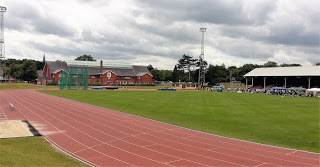 * The Garrison track at Aldershot.Out of the school gates and I was off to Aldershot where Sydney took part in the Army track and field championships of 1945 at the Garrison ground beside Queens Road – an impressive venue still very much in use today. Sydney had ended the war serving as a corporal in the REME, but since summer 1944 had suffered from rheumatic fever which led to four months in hospital, where he was warned he’d probably never run again.
* The Garrison track at Aldershot.Out of the school gates and I was off to Aldershot where Sydney took part in the Army track and field championships of 1945 at the Garrison ground beside Queens Road – an impressive venue still very much in use today. Sydney had ended the war serving as a corporal in the REME, but since summer 1944 had suffered from rheumatic fever which led to four months in hospital, where he was warned he’d probably never run again.But after war ended in May 1945 he proved the doubters wrong and by the time of these Army champs in July felt fully fit again. Despite a stiff breeze he thrilled the assembled spectators at Aldershot, flying home to win the invitation mile in 4:14.8, by a huge margin of 16 seconds. It was an Army all-time record, and his fastest mile in more than a year.
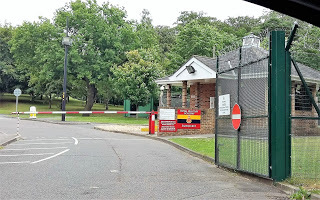 * The RMA at Sandhurst - scene of the 1949 Southern XC champs.My next port of call was Camberley, home of the Royal Military Academy, Sandhurst. In these days of high security it was tough getting a glimpse of the Oak Grove Stadium facilities and surroundings, where Sydney competed several times, both on the track and then over the fields near the end of his celebrated career.
* The RMA at Sandhurst - scene of the 1949 Southern XC champs.My next port of call was Camberley, home of the Royal Military Academy, Sandhurst. In these days of high security it was tough getting a glimpse of the Oak Grove Stadium facilities and surroundings, where Sydney competed several times, both on the track and then over the fields near the end of his celebrated career.He came here on a chilly February day to run the 1949 Southern Cross-country Championships for the very last time. He was by now 34 and had long since given up track, but still enjoyed helping his club over the country. In a tough 10-mile contest within the grounds of Sandhurst, he came a modest 16th in a time of 57:57, around two-and-a-half minutes behind winner Alec Olney (Thames Valley). Not one of his better days, but he was still the leading runner from Blackheath, who were grateful he had turned out.
Directly from here it was over to Ascot racecourse, the venue of another Southern Cross-country championships, this in 1947, at which Sydney fared a little better, coming home fifth, a minute or so behind winner Len Herbert of Belgrave. Sydney was smaller and lighter than the majority and his nimble footwork was well suited to the frozen ground on this icy cold day. The wind was bitter and there was further heavy snowfall during proceedings. It wasn’t a day for hanging around, and although he was his usual quiet and polite self, Sydney must have been irritated when the start of the main race was delayed. It was all because the chief official was desperate to get a photo of superstar Sydney but couldn’t locate the photographer for several minutes!
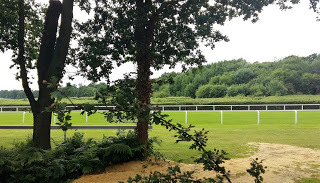 * The racecourse at Ascot Heath - scene of the 1947 Southern XC champs. Across Ascot Heath, scene of many a notable horse race meeting, regally patronised and otherwise, Sydney and teammate Monshall ran steadily together throughout the 10-mile contest, well established in the top 15 in a field of nearly 300 runners. With less than a mile to go, Sydney told his teammate he thought he could make up few places, and promptly accelerated away. He passed at least seven men with a wonderful turn of speed to thrill the frozen crowd at the finish-line. It was well worth the effort, for it pushed Blackheath into third place in a fierce team event involving 30 clubs.
* The racecourse at Ascot Heath - scene of the 1947 Southern XC champs. Across Ascot Heath, scene of many a notable horse race meeting, regally patronised and otherwise, Sydney and teammate Monshall ran steadily together throughout the 10-mile contest, well established in the top 15 in a field of nearly 300 runners. With less than a mile to go, Sydney told his teammate he thought he could make up few places, and promptly accelerated away. He passed at least seven men with a wonderful turn of speed to thrill the frozen crowd at the finish-line. It was well worth the effort, for it pushed Blackheath into third place in a fierce team event involving 30 clubs. * PROJECT SYDNEY is more than just my forthcoming book about the forgotten British champion Sydney Wooderson. It also incorporates my 60th birthday ‘challenge’ – which was to visit and run at 60 of the places where Sydney raced during his remarkable career - all to be done while I am 60! This blog records the progress of that challenge. Conveniently, it should also help keep me fit and assist with research for the book!
Published on September 23, 2016 07:16
September 8, 2016
Lovelock left stunned as teenager Sydney comes of age
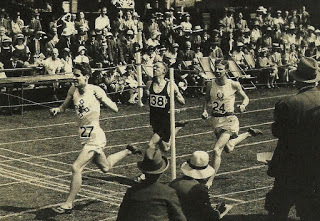 * Sydney Wooderson (No.38) pips Jack Lovelock (24) at the post.ON a scorching Saturday afternoon in the summer of 1934, around 5,000 people eagerly squeezed into the Guildford cricket ground, many only there to see one man - world record miler Jack Lovelock.
* Sydney Wooderson (No.38) pips Jack Lovelock (24) at the post.ON a scorching Saturday afternoon in the summer of 1934, around 5,000 people eagerly squeezed into the Guildford cricket ground, many only there to see one man - world record miler Jack Lovelock. To their delight, this 12th staging of the Southern AAA championships would live long in the memory - not because of the run by Kiwi legend Lovelock, but because Britain discovered a new superstar of its own. Step forward a small, bespectacled teenager called Sydney Wooderson!
More than eight decades later, I stopped off at the Woodbridge Road ground as part of my current tour of 60 of Sydney’s race venues (see * below). As I jogged around I tried to imagine how nervous and inhibited the young Sydney must have felt all those years ago, arriving here for the biggest race of his life thus far, and seeing the size of the expectant crowd.
Sydney had emerged as a real talent just three weeks earlier when he won the Kent county mile title at Belvedere. However, the talent on show here in Guildford was a whole new world for this mild-mannered little runner from South London. Before the mile race his chances of doing well were boosted when the news broke that 27-year-old Olympian and Welshman Reg Thomas would not be defending his title. However, this good news was countered by the controversial decision to allow 28 men to run the mile final. In addition to the stifling heat, this was going to be one crowded race!
 * Guildford cricket ground in 2016.
* Guildford cricket ground in 2016. The grass track was in good condition but with such a big field it proved a slow start. By halfway (two laps in 2:07.4), L.R.Pearce had settled in front with 22-year-old Aubrey Reeve tight on his heels. At the bell Jerry Cornes took the lead with Lovelock close behind him. Reeve was content to stay third until the top bend when he surged to the front with 200 yards to go, and opened a winning lead. It was the race of his life and he came home in 4:14.8, beating his personal best by more than six seconds.
Lovelock, looking rather stunned, had worked hard to chase Reeve down the home straight but couldn’t get there. As he approached the line and it became clear he was a beaten man, there was an even bigger shock in store as Sydney finished with an incredible burst and flew past to narrowly take second place right on the line. He and Lovelock were both given a time of 4:15.2, a personal best for Sydney by an astonishing 12.2 seconds.
The crowd was buzzing for ages after this thriller, and subsequent track and field events felt anti-climactic. The pressmen in attendance frantically compiled reports hailing the dramatic arrival of these two great new hopes for Britain in the mile, Reeve and youngster Wooderson.
In 2008 the personal journals of Jack Lovelock were published in New Zealand in book form by David Colquhoun, and these provide a fascinating insight into how Lovelock reacted to his shock defeat. Runners are notorious for finding all sorts of reasons to explain poor performance, and the 24-year-old charismatic Lovelock was no exception. He cited the fact that before the race he’d had a tiring week of exams at Oxford University, where he was studying medicine on a Rhodes scholarship.
He wrote: “[The week] left me very tired indeed. I had reckoned that a 4:19 would be good enough to win judging on current form, and was amazed to find two comparitively unknown milers doing around 4.15. The day was scorching hot with no appreciable wind and the track really good fast grass.
 * All quiet in 2016 . . . Guildford Cricket Ground. “At the bell [Cornes] went into the lead moving very fast and powerfully. I followed on his heels but 220 from home he slackened and Reeve passed us. I foolishly let him go, thinking Jerry would respond and not wanting to be forced wide by Jerry on the bend. But Jerry had had enough, a fact which I realised only when Reeve had a 12-yard lead on me. Then I did move out and around Jerry but it was too late and not only did I fail to make up the last three yards, but tailed off so much that I was myself caught by Wooderson on the tape.”
* All quiet in 2016 . . . Guildford Cricket Ground. “At the bell [Cornes] went into the lead moving very fast and powerfully. I followed on his heels but 220 from home he slackened and Reeve passed us. I foolishly let him go, thinking Jerry would respond and not wanting to be forced wide by Jerry on the bend. But Jerry had had enough, a fact which I realised only when Reeve had a 12-yard lead on me. Then I did move out and around Jerry but it was too late and not only did I fail to make up the last three yards, but tailed off so much that I was myself caught by Wooderson on the tape.” Lovelock, not surprisingly, seemed embarrassed at being beaten in a high-profile race by two relative unknowns, thanks at least partly to his tactical gaffe. It was a big wake-up call for the popular Kiwi and a breakthrough race Sydney Wooderson would never forget.
Interviewed in old age, Sydney would look back and name Guildford as one of the best six performances of his glorious 20-year career.
* PROJECT SYDNEY is more than just my forthcoming book about the forgotten British champion Sydney Wooderson. It also incorporates my 60th birthday ‘challenge’ – which was to visit and run at 60 of the places where Sydney raced during his remarkable career - all to be done while I am 60! This blog records the progress of that challenge. Conveniently, it should also help keep me fit and assist with research for the book!
Published on September 08, 2016 07:05
August 26, 2016
The BBC legend who idolised Sydney and slept with his trophy!
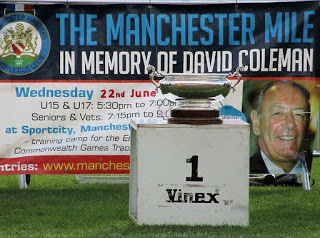 * Sydney Wooderson won the first Manchester Mile, David Coleman the sixth.NEARLY halfway through my tour of Sydney Wooderson race venues and the chance arose to visit Fallowfield Stadium in Manchester. It’s a spot steeped in sporting history, but there was no point in punching the name into the Satnav for it was demolished 40 years ago!
* Sydney Wooderson won the first Manchester Mile, David Coleman the sixth.NEARLY halfway through my tour of Sydney Wooderson race venues and the chance arose to visit Fallowfield Stadium in Manchester. It’s a spot steeped in sporting history, but there was no point in punching the name into the Satnav for it was demolished 40 years ago!The old ground proudly staged top-class athletics and cycling for many years, as well as the 1893 FA Cup final. It stood on what is now University of Manchester land, sited between the huge hall of residence known as Owens Tower and the rather more attractive Firs Pavilion.
In the summer of 1939 a landmark athletics promotion here at Fallowfield pulled in a big crowd who watched awestruck as Sydney Wooderson became the first man ever to run three quarter-mile laps in under three minutes. He set a world record of 2:59.5 in the process and confirmed his status as favourite for 1500 metres gold at the forthcoming 1940 Tokyo Olympics. Sadly war intervened a few months later and those Games never happened.
 * Fallowfield Stadium in 1976, shortly before demolition.It was a hot day for the three-quarter mile race and the Fallowfield track sparkled in pristine condition. The other four runners shot off at lightning pace, Sydney sheltering behind them in pre-arranged fashion. He completed 440 yards in 57.9 seconds, and on the middle lap moved into second place, passing the half-mile in two minutes exactly.
* Fallowfield Stadium in 1976, shortly before demolition.It was a hot day for the three-quarter mile race and the Fallowfield track sparkled in pristine condition. The other four runners shot off at lightning pace, Sydney sheltering behind them in pre-arranged fashion. He completed 440 yards in 57.9 seconds, and on the middle lap moved into second place, passing the half-mile in two minutes exactly.The pacemakers were doing a sterling job and halfway through the third and final lap Sydney lengthened his stride to surge past leader Kierans (Salford Harriers) in dramatic fashion. He came home with a 15-yard lead and, more importantly, beat his own world best by 1.34 seconds. The crowd went wild.
According to the Daily Telegraph: “It was one of the greatest efforts Wooderson has made in his career, and no man could have put more into his final running than he did after coming into the last bend.”
 * Sydney Wooderson turns on the style at Fallowfield in June 1940.Sydney stayed overnight locally after the race and the following morning left for New York by ship from Liverpool, accompanied by his coach, the Olympian Albert Hill. Amid great fanfare he was off to tackle the best Stateside runners in the famous Princeton ‘Mile of the Century’ contest. The trip would take around five days and the only training he would manage on board would be gentle jogging on rubber matting laid on the promenade deck. Sydney would tackle a further four races over a five-year period at Fallowfield Stadium. His wartime return here in June 1943 would be to contest the inaugural ‘Manchester Mile’, which he also won in style. This race grew into a popular annual event and the 1949 winner would be 23-year-old David Coleman, a reporter on the Stockport Express and member of Stockport Harriers. Coleman, of course, later quit running through injury and went on to become a legendary BBC commentator. He was so overjoyed at emulating his sporting hero Sydney Wooderson at the Manchester Mile that he confessed to taking the trophy to bed with him afterwards!
* Sydney Wooderson turns on the style at Fallowfield in June 1940.Sydney stayed overnight locally after the race and the following morning left for New York by ship from Liverpool, accompanied by his coach, the Olympian Albert Hill. Amid great fanfare he was off to tackle the best Stateside runners in the famous Princeton ‘Mile of the Century’ contest. The trip would take around five days and the only training he would manage on board would be gentle jogging on rubber matting laid on the promenade deck. Sydney would tackle a further four races over a five-year period at Fallowfield Stadium. His wartime return here in June 1943 would be to contest the inaugural ‘Manchester Mile’, which he also won in style. This race grew into a popular annual event and the 1949 winner would be 23-year-old David Coleman, a reporter on the Stockport Express and member of Stockport Harriers. Coleman, of course, later quit running through injury and went on to become a legendary BBC commentator. He was so overjoyed at emulating his sporting hero Sydney Wooderson at the Manchester Mile that he confessed to taking the trophy to bed with him afterwards!The race was revived in 2014 and I was able to take part myself in the 2016 edition. It took place just an hour or two after my visit to nearby Fallowfield. Now that’s what I call good timing! It was a highly enjoyable evening’s racing, even though I’m now far too ancient to threaten my mile PB of 4 mins 46 secs. The track and conditions at Sportcity were superb, but when your PB is 25 years old you can be fairly sure it’s unbreakable! By coincidence, that mile PB was set exactly 25 years ago today (August 26, 1991), when my running ‘career’ was in its eighth year. A quarter of a century later, there’ll certainly be no more lifetime PBs to celebrate . . . so thank goodness somebody dreamed up the age-group system!
* PROJECT SYDNEY is more than just my forthcoming book about the forgotten British champion Sydney Wooderson. It also incorporates my 60th birthday ‘challenge’ – which was to visit and run at 60 of the places where Sydney raced during his remarkable career - all to be done while I am 60! This blog records the progress of that challenge. Conveniently, the challenge should also help keep me fit and assist with research for the book!
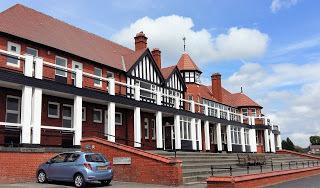 * Fallowfield track is long gone, but neigbouring Firs Pavilion remains in 2016.
* Fallowfield track is long gone, but neigbouring Firs Pavilion remains in 2016.
Published on August 26, 2016 08:12
August 19, 2016
The tour continues . . . . Sydney gets a taste of northern exposure

* Sydney in his pomp - and Worsley fields as they are now.
SOON after athletics had settled back into near normality after the Second World War, the sport’s big-wigs made a ground-breaking decision regarding the Inter-Counties cross-country champs.
For the very first time the North of England was awarded the privilege of hosting this showpiece! Grange Farm at Worsley, on the outskirts of Manchester, was the chosen venue. To welcome those ‘southern softies’ the locals laid on plenty of rain and mud!
On Saturday 15 January 1949, after completing his working week in a central London office, Sydney Wooderson jumped on a special breakfast-time train from Euston, along with four colleagues from Blackheath Harriers and dozens of others representing other southern counties.
They were met at Manchester’s Piccadilly station by a fleet of buses which ferried them to Worsley Secondary Modern School. Here the runners were pleased to find what one Blackheath man called “Excellent changing and washing accommodation” – although he did follow up this compliment with a dig about the “traditional Manchester weather” as the rain continued to tip down!
I had to pore over several maps to locate the area they used for the race, before visiting this spot as part of my 2016 nationwide tour of Sydney Wooderson race venues*.
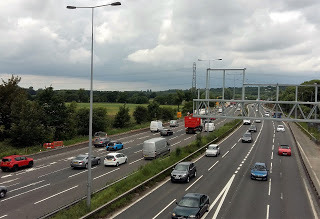
* The M60 blasts through where Sydney and pals once ran.
It was quite tricky trying to picture the scene at Grange Farm back in January 1949 as the weather on my visit was warm and dry and there was barely another person in sight as I scanned the horizon – merely the unrelenting buzz of traffic from the point nearby where the M60 and M602 motorways meet.
Although the Inter-Counties race had never been this far north until 1949, the last English National before the war had in fact been on this very course. Runners who recalled that race said conditions were appalling that day in 1939, but that ten years later things were even worse.
The Inter-Counties involved four laps of roughly 1.75 miles each to negotiate, slippery the whole way with countless areas of deep, thick mud. It was a severe test for everyone and the race developed into a rather uneventful slog. Men were strung out in a long procession, apparently more intent on survival than overtaking people ahead.
Although Sydney, the reigning national champion, was famously light on his feet, this was a course not even he could have enjoyed. One suspects his motivation on a day like this was not at its highest. His star was clearly on the wane by the beginning of 1949: he’d achieved virtually all he wanted to in running, and at the age of 34 a more settled life in the suburbs bringing up a family was beckoning.
A year earlier, in January 1948, he’d won the Kent cross-country title and a fortnight later was third in the Inter-Counties, but this time round he was fourth and seventh, respectively, in the equivalent races. He’d already retired from track racing by now, and many observers suspected he’d also be hanging up the cross-country spikes soon.
Home county Lancashire ran like men inspired at Worsley – their six scorers all among the first 20 past the post. They won the team prize comfortably, with Sydney’s Kent team back in fourth. Sydney himself clocked a time of 49 minutes dead for the seven-mile course, some 45 seconds behind winner Ron Williams (Lancs). Sydney had never featured at the front end of the race and the only real drama of the day came when Williams burst past Alec Olney (Middlesex) and Geoff Saunders (Lancs) in the final few yards to snatch victory.
On the long train journey back to London Sydney must have contemplated the fact that conditions had been so tough his average pace had been only seven-minutes-per-mile – almost certainly his slowest in any serious race since boyhood. Was a great career coming to an end?
* PROJECT SYDNEY is more than just my forthcoming book about the forgotten British champion Sydney Wooderson. It also incorporates my 60th birthday ‘challenge’ – which was to visit and run at 60 of the places where Sydney raced during his remarkable career - all to be done while I am 60! This blog records the progress of that challenge. Conveniently, the challenge should also help keep me fit and assist with research for the book!
 * Still some green and pleasant spots 67 years later!
* Still some green and pleasant spots 67 years later!
Published on August 19, 2016 08:29



